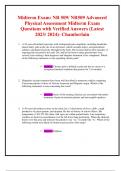Midterm Exam: NR 509/ NR509 Advanced Physical Assessment Midterm Exam Questions with Verified Answers (Latest 2023/ 2024) - Chamberlain 1. A 42 -year-old architect presents with widespread pain complaints, including headaches almost daily, pain at the site of an old motor vehicle accident injury, and generalized achiness and hypersensitivity throughout the body. He recounts that his first episodes of ongoing pain occurred in his early 20s, and he has been to many practitioners over several years seeking a firm diagnosis and adequate treatment of his complaints. Which of the following statements is true regarding chronic pain? ✓ Answer: Chronic pain is defined as pain not due to cancer or a recognized medical condition that persists for >3 -6 months. 2. Disparities in pain treatment have been well described in numerous studies comparing Caucasian patients to those of African American and Hispanic origin. Which of the following statements is true concerning this issue? ✓ Answer: biases of the treating clinic ian are associated with under -
treatment of pain in minority patients and non -english speakers. 3. A 39 -year-old architect comes to the clinic for a 2 -day history of fever, chills, cough productive of green sputum, and dyspnea. He has no history of serious illness. His temperature is 101.2ºF. His other vital signs are within normal limits. Late inspiratory crackles are heard on auscultation over the left lower lung posteriorly. When the clinician listens over that area and instructs the patient to say "ee," it sounds like "A." Which of the following would most likely be found on percussion of his lungs? ✓ Answer: Dullness 4. A student is practicing the performance of a lung examination on a classmate. Which of the following is the correct order for performing the components of the lung examination? ✓ Answer: Inspect, Palpate, Percussion, Auscultation 5. A 14 -year-old high school student comes to the clinic for a 3 -month history of periodic dyspnea when playing basketball. It resolves shortly after resting. He has not had fever, chills, cough, sputum production, or chest pain. He has no history of serious illness. Based on the boy's history, asthma is suspected. Which of the following sounds heard on expiration during lung auscultation would be most suggestive of asthma? ✓ Answer: Wheezes 6. A clinician is percussing the lungs of a patient with chronic obstructive pulmonary disease to see if they sound hyperresonant. Which of the following is an example of good technique for percussion? ✓ Answer: Strike using the tip of the third finger 7. A 29 -year-old waiter comes to the clinic for a 2 -month history of a cough. When he lowers his gown so the clinician can listen to his lungs, the clinician notices a depression of the lower part of his sternum. Which of the following best describes the appearance of his chest? ✓ Answer: Pectus Excavatum 8. A 13 -year-old girl is brought by her mother to the clinic one day before the start of eighth grade because of a 3 -day history of episodes of shortness of breath. When she gets the shortness of breath, she also notices tingling around her lips. She has no fever, cough, sputum production, or chest pain. She has no history of serious illness and takes no medications. Vital signs are within normal limits. Cardi ac, lung, and extremity examinations show no abnormalities. Which of the following is the most likely diagnosis? ✓ Answer: Anxiety 9. A 70 -year-old patient has suspected chronic obstructive pulmonary disease. The clinician instructs the patient to take a d eep breath in, and then with his mouth open, breathe out as fast and completely as he can. For what is the clinician checking? ✓ Answer: Forced expiratory time 10. After examining a patient who is in the hospital for shortness of breath, the clinician recor ds the following for lung examination: "There is dullness to percussion over the right lung base. Breath sounds are absent at the right lung base. There are no crackles, wheezes, or rhonchi. There are no transmitted voice sounds." Which of the following is the most likely diagnosis? ✓ Answer: Atelectasis 11. A 16 -year-old boy is brought to the Emergency Department (ED) after a motor vehicle accident for shortness of breath for 1 hour. A chest x -ray shows a rib fracture and a pneumothorax on the right side. T he ED physician decides that a chest tube needs to be placed in the fourth intercostal space. How does he determine where the fourth intercostal space is? ✓ Answer: He finds the sternal angle and then moves his fingers laterally to the second rib. He then walks down to the second intercostal space, third rib, third intercostal space, fourth rib and then the fourth intercostal space. 12. A 68 -year-old retired administrative assistant complains of a 3 -month history of recurring pain after ambulating that radiates from her back in the upper lumbar region into both buttocks, bilateral thighs, and mid -calf regions. Her pain is typically improved by sitting or by leaning forward. The origin of her pain is likely secondary to which of the following?




